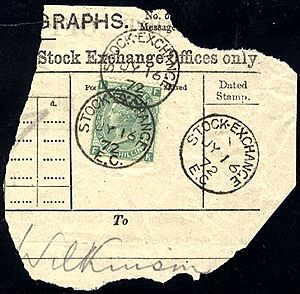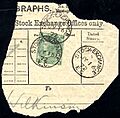Stock Exchange forgery 1872–73 facts for kids
The Stock Exchange forgery was a big fraud (a trick to steal money) that happened at the London Stock Exchange between 1872 and 1873. It involved fake postage stamps used on telegram forms. What's amazing is that this trick wasn't found out until more than 25 years later!
How the Trick Worked
In 1870, the telegraph systems in the United Kingdom became part of the Post Office. Telegraphs were super helpful for the Stock Exchange. They allowed stock prices to be shared very quickly.
If someone at the Stock Exchange wanted to send a telegram, they would write their message. Then they would pay one shilling or more to a clerk. The clerk would give them a 1 shilling green postage stamp to put on the form. More stamps were added if the message was longer. The clerk would then cancel the stamp with a postmark to show it was paid for.
However, some big companies that sent many telegrams had a special deal. They didn't pay right away. Instead, their telegram forms would be stamped and canceled the next day. The companies would pay a total amount later. This meant customers never actually saw the stamps being put on.
The Secret Plan
A clerk, or maybe a few clerks, started using fake stamps on these forms. This way, they could steal the one shilling fees. They didn't have to use up the real stamps, which were checked by auditors.
The trick worked because the fake stamps looked good enough. Also, customers never kept the forms. After a telegram was sent, the forms were stamped in private. Then they were put into bags for storage and later thrown away. Because of the special deal with the companies, the stamps were not seen directly by anyone important. The forms were stamped and canceled the day after they were sent. This meant the fake stamps were never closely checked.
It's hard to know exactly how the fraud happened. But it seems a head clerk named George E. Smith might have worked with T. H. Wright and Benjamin Hind. They likely put the fake stamps on the forms. Years later, in 1910, an official from the Post Office interviewed Smith. But what he said was never made public.
How the Trick Was Found Out
The fraud was not discovered at the time. It might have stayed a secret if all the forms had been destroyed. But the Stock Exchange kept them for a while. Later, they were thrown away as waste paper. Some of these forms, however, ended up with stamp dealers.
The fraud finally came to light in 1898. A young stamp collector named Charles Nissen noticed something strange. The stamps he was looking at were missing a special "spray of roses" watermark. This watermark should have been there. Once Nissen noticed this, other problems with the fake stamps became clear.
- Corner Letters: Real British stamps had letters in the corners. These letters showed where the stamp was on the sheet. Some fake stamps had "impossible" letters. This meant they didn't match any real sheet positions. The letters were also a bit bigger and less sharp than on real stamps. Later fake stamps were better, but the corner letters were still wrong.
- Watermarks: Real stamps had a watermark (a faint design in the paper). The fake stamps did not have any watermark.
- Printing Quality: Real stamps looked a bit sharper. The fake ones were not as well printed. This didn't matter much because the fake stamps were never meant to be seen by customers.
The fake stamps were made for both printing plate 5 and plate 6 of the real stamp. The plate 6 fakes were better quality.
We know the fraud happened in June and July 1872 from the postmarks. But it was probably going on for much longer. It might have lasted until 1876. A lot of fake stamps were made. One shilling was a lot of money back then. So, the people behind the fraud likely made a lot of profit. They were never found out during their lives. Today, these fake stamps, especially the plate 6 ones, are actually worth more to collectors than the real stamps!
See also
- Philatelic fakes and forgeries
Images for kids



